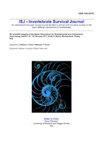Evolutionary insights on a novel mussel-specific foot protein-3 gene family
IF 1.2
4区 农林科学
Q4 IMMUNOLOGY
引用次数: 1
Abstract
Silky byssus threads enable a number of marine and freshwater bivalve mollusks to attach themselves to hard substrates. Byssus production is an energy-costly process, which accompany the switch from planktonic to sessile life. Pointing the attention to a small foot protein (fp-3α) first identified in Perna viridis and abundantly secreted during the bissogenesis, we report the presence of a fp-3α gene family in species of the Mytilus complex, byssogenic bivalve mollusks mostly inhabiting marine waters. In the genome of Mytilus galloprovincialis we identified twelve fp-3α genes showing differences in exon-intron organization and suggesting that, as in the case of arthropod and mollusk defensins, exon shuffling could have played an important role in the evolution of this gene family. Also, the different tissue expression patterns of these mussel genes support their functional diversification. All predicted fp-3α proteins curiously possess a Csαβ three-dimensional motif based on 10 highly conserved cysteines and exhibit structural similarity to invertebrate defensins. The role of these small cysteine-rich proteins in supporting the byssus-mediated mussel adhesion or their action as host defence peptides remains to be established with further study.一个新的贻贝特异性足蛋白-3基因家族的进化见解
丝质足丝使许多海洋和淡水双壳类软体动物能够将自己附着在坚硬的基质上。足丝的生产是一个耗费能源的过程,伴随着从浮游生物到无根生物的转变。我们将注意力集中在一个小足蛋白(fp-3α)上,该蛋白最初在紫鲷(Perna viridis)中被发现,并在双壳类软体动物的双壳生过程中大量分泌,我们报道了一个fp-3α基因家族在贻贝复合体(Mytilus complex)中的存在。在Mytilus galloprovincialis的基因组中,我们鉴定出12个fp-3α基因在外显子-内含子组织上存在差异,这表明,与节肢动物和软体动物防御素的情况一样,外显子改组可能在该基因家族的进化中发挥了重要作用。此外,这些贻贝基因的不同组织表达模式支持其功能多样化。所有预测的fp-3α蛋白都具有基于10个高度保守的半胱氨酸的Csαβ三维基序,并表现出与无脊椎动物防御蛋白的结构相似性。这些富含半胱氨酸的小蛋白在支持足丝介导的贻贝粘附或它们作为宿主防御肽的作用中的作用仍有待进一步研究。
本文章由计算机程序翻译,如有差异,请以英文原文为准。
求助全文
约1分钟内获得全文
求助全文
来源期刊

ISJ-Invertebrate Survival Journal
IMMUNOLOGY-ZOOLOGY
CiteScore
2.10
自引率
0.00%
发文量
0
审稿时长
>12 weeks
期刊介绍:
Invertebrate Survival Journal (ISJ) is an international and open access journal devoted to prompt and innovative studies on the basic defense mechanisms in invertebrates, in particular with a view to identifying biotechnologies able to act against derived diseases and related economic damage.
Contributions will be mainly in the form of Letters to the Editor, Visions and Perspectives, Short Communications, Technical Reports, Research Reports, Review, Minireview and Reports of Meetings. Letters to the Editor can be commentaries or perspectives on invertebrate defence mechanisms or replies to the data published in ISJ.
 求助内容:
求助内容: 应助结果提醒方式:
应助结果提醒方式:


